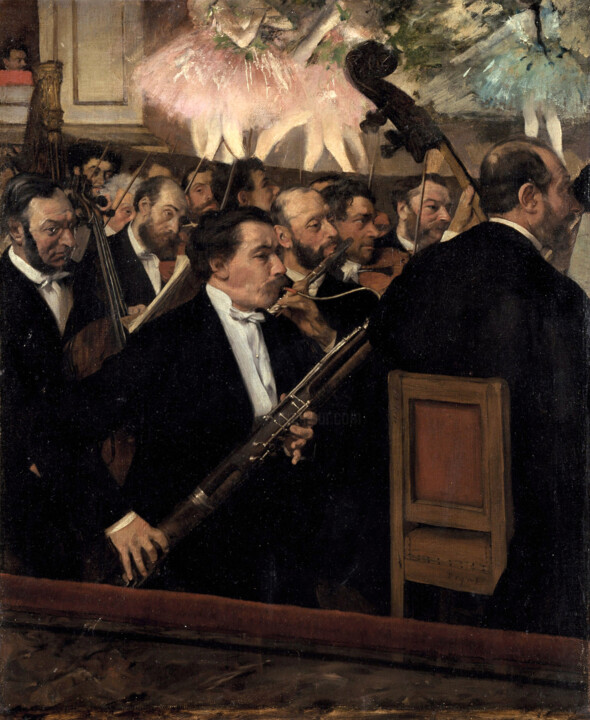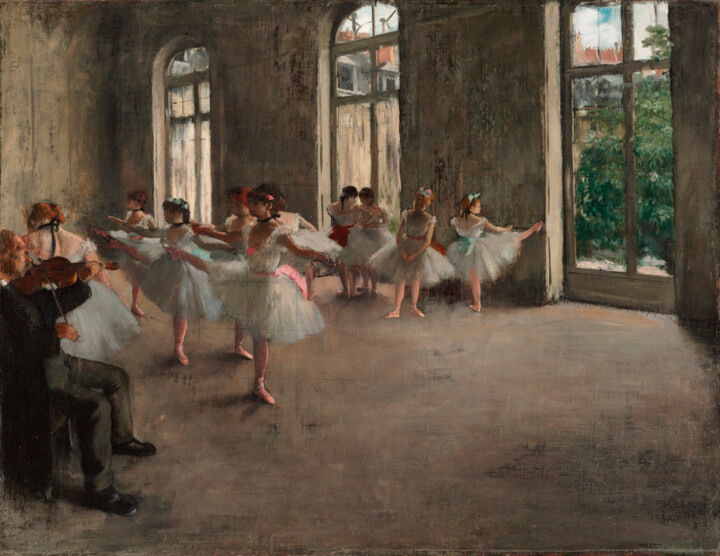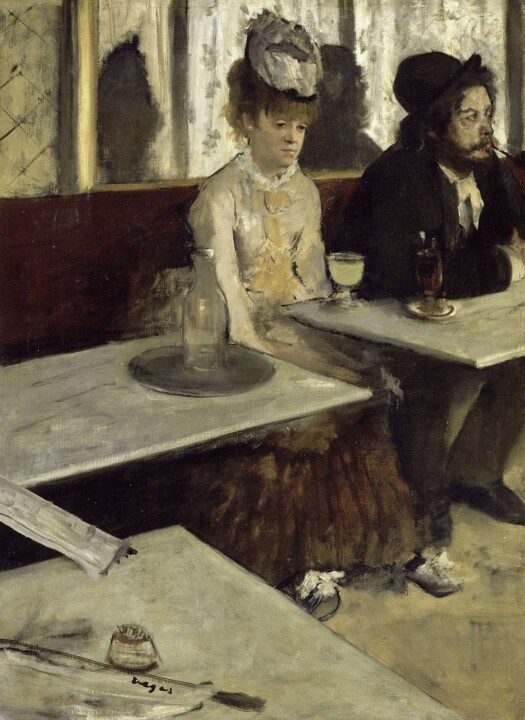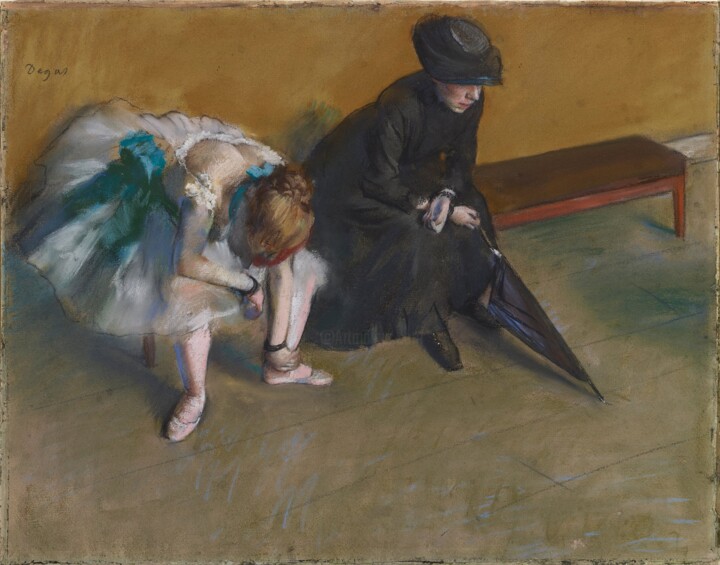 Edgar Degas - Self-portrait, 1863. Oil on canvas. Calouste Gulbenkian Museum, Lisbon.
Edgar Degas - Self-portrait, 1863. Oil on canvas. Calouste Gulbenkian Museum, Lisbon.
Who was Edgar Degas?
Edgar Degas, born on July 19, 1834, in Paris, France, led a remarkable life as a renowned artist. He hailed from a wealthy family and initially studied law, but his passion for art led him to pursue a career as a painter. Degas received formal artistic training at the École des Beaux-Arts in Paris and embarked on extensive travels to Italy, where he studied the works of the Renaissance masters.
Degas became associated with the Impressionist movement, although he maintained his own unique style and interests. He focused on capturing everyday life and its fleeting moments, with subjects ranging from ballet dancers and racehorses to intimate domestic scenes. Degas was known for his technical skill, meticulous attention to detail, and ability to convey movement and light in his artworks.
While Degas enjoyed recognition and success during his lifetime, he also faced personal challenges. He was known for his private and reclusive nature, and his declining eyesight in later years impacted his ability to create art. Nevertheless, Degas continued to experiment with new mediums, including sculpture and pastels, and produced a remarkable body of work that left an indelible mark on the art world.
Edgar Degas passed away on September 27, 1917, in Paris, leaving behind a legacy of innovation and artistic excellence.
 Edgar Degas - Self portrait photograph, ca. 1895. Harvard Art Museum
Edgar Degas - Self portrait photograph, ca. 1895. Harvard Art Museum
Early period
During his early period, Edgar Degas received formal training in art. He began his studies at the École des Beaux-Arts in Paris, where he learned drawing, painting, and sculpture. Under the guidance of his teachers, he honed his technical skills and gained a solid foundation in the traditional academic style.
During the 1860s, Edgar Degas began to gain recognition and establish himself as a professional artist. Degas focused on traditional subjects such as historical and mythological scenes, as well as portraits and genre paintings. He showcased his technical skills in creating highly detailed and meticulously executed works. Degas also explored the influence of the Old Masters, particularly in his travels to Italy, where he studied and absorbed the techniques of Renaissance art. While he had not fully embraced the Impressionist style during this period, Degas started to experiment with capturing the effects of light and movement in his works, laying the foundation for his future experimentation and innovation.
During his early years, Edgar Degas created several notable and influential works. Some of his famous works from this period include: "The Bellelli Family" (1858-1867), "Young Spartans Exercising" (1860), "The Orchestra of the Opera" (ca. 1870), "The Dancing Class" (ca. 1870). These early works by Degas already exhibit his technical skill, attention to detail, and his fascination with capturing human figures in various settings. They set the foundation for the themes and stylistic developments that would come to define his later works.
 Edgar Degas - The Dancing Class, ca. 1870. Oil on wood. 19.7 x 27 cm. Metropolitan Museum of Art
Edgar Degas - The Dancing Class, ca. 1870. Oil on wood. 19.7 x 27 cm. Metropolitan Museum of Art
Mature period
In the 1870s, Edgar Degas experienced significant developments and influences in his art. During this period, he fully embraced the Impressionist movement and began experimenting with new techniques and subject matter. While he did not align himself strictly with the Impressionist group, he participated in several of their exhibitions and shared many of their artistic principles. Degas embraced the use of loose brushwork, vibrant colors, and the depiction of modern life. He sought to capture the fleeting effects of light and atmosphere in his paintings, often focusing on scenes of ballet dancers, racehorses, and everyday urban life. Degas's innovative approach to composition and his exploration of unconventional angles and cropping techniques were in line with the principles of Impressionism. While he maintained his unique style and subject matter, Degas's contributions to the movement and his association with other Impressionist artists solidified his place within the Impressionist canon. The 1870s were a transformative decade for Degas, as he continued to refine his artistic approach and establish himself as a key figure within the Impressionist circle.
During his mature period, Edgar Degas became recognized for his unique approach to composition, use of color, and his ability to capture fleeting moments and everyday scenes. Degas focused extensively on the world of ballet, producing a significant body of work depicting dancers in various stages of rehearsal, performance, and behind-the-scenes moments. His paintings and sculptures showcased his mastery of depicting movement, capturing the grace, poise, and athleticism of the dancers. Additionally, Degas expanded his subject matter to include scenes of horse racing, social gatherings, and even intimate depictions of women bathing.
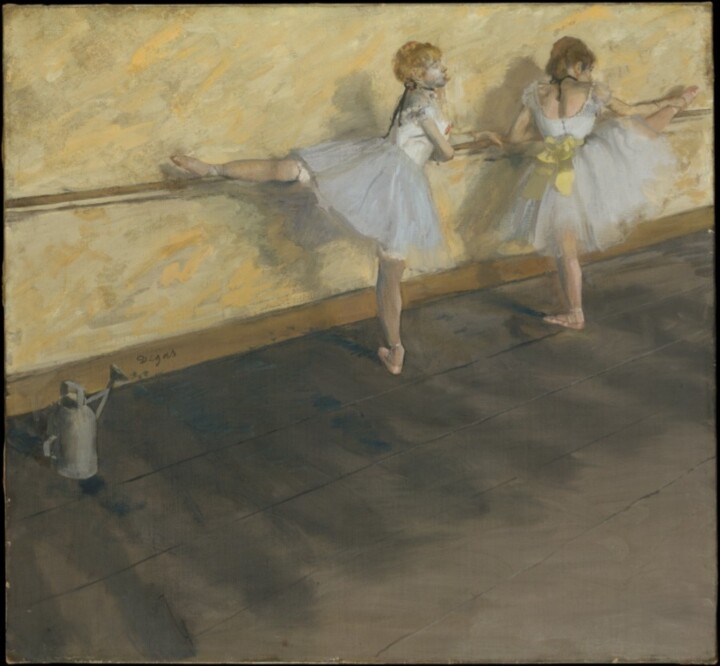 Edgar Degas - Dancers Practicing at the Barre, 1877. Mixed media on canvas. 75.6 x 81.3 cm. Metropolitan Museum of Art
Edgar Degas - Dancers Practicing at the Barre, 1877. Mixed media on canvas. 75.6 x 81.3 cm. Metropolitan Museum of Art
In the 1880s, Edgar Degas continued to evolve his artistic style and explore new avenues of creativity. During this period, he became increasingly interested in depicting the private and intimate moments of women in their domestic settings. He produced a series of artworks showcasing women bathing, combing their hair, or engaged in other solitary activities. These works displayed his mastery of composition, use of color, and ability to capture the subtle nuances of light and shadow. Additionally, Degas delved deeper into the realm of sculpture, experimenting with new materials and techniques. His sculptures often depicted dancers in dynamic poses, further emphasizing his fascination with capturing movement and the human form. The 1880s marked a phase of innovation and introspection for Degas, as he pushed the boundaries of his artistic expression and continued to leave an indelible mark on the art world.
Some of his famous works from this period include: "Little Dancer Aged Fourteen'' (1878-1881), "The Absinthe Drinker" (1875-76), “Dancers Practicing at the Barre” (1877), "The Tub" (1886). These famous works from Degas's mature period demonstrate his continued exploration of his preferred themes, such as ballet, the human form, and everyday life. They reflect his technical mastery, his keen observation skills, and his ability to capture the nuances of light, movement, and emotion.
Late period
During his late period, Edgar Degas faced various challenges, including declining eyesight and health issues. As a result, he shifted his focus from painting to other mediums, particularly pastels, drawing, and sculpture. Degas became increasingly experimental and pushed the boundaries of traditional artistic techniques. He embraced a more spontaneous and expressive style, often using bold, vibrant colors and loose brushwork. In his later works, Degas explored themes of isolation, introspection, and the human form in unconventional ways. He produced fewer works and preferred to keep them in his personal collection rather than exhibiting them publicly. While his productivity declined, Degas's art from the 1900s still showcased his signature style and themes, demonstrating his unwavering dedication to his craft until his passing in 1917.
The legacy of Edgar Degas is significant and enduring. As one of the prominent figures of the Impressionist movement, Degas played a crucial role in reshaping the art world. His innovative approach to composition, use of vibrant colors, and keen observation of modern life continue to inspire artists to this day. Degas's exploration of subjects such as ballet dancers, racehorses, and everyday scenes provided a fresh perspective, capturing the essence of movement and evoking a sense of realism. His artistic legacy lives on through his vast body of work, which can be found in museums and galleries worldwide, serving as a testament to his immense talent and lasting impact on the art world.
Most famous works by Edgar Degas
In his most famous works, Edgar Degas predominantly employed an Impressionist style with his own distinct variations. Degas had a keen eye for capturing the effects of light and its interaction with the subjects he portrayed. He utilized vibrant colors, loose brushwork, and an emphasis on capturing the effects of light and atmosphere. Degas was particularly skilled at depicting human figures, showcasing his ability to capture gestures, poses, and expressions with great accuracy and sensitivity. Degas's most renowned subjects, such as ballet dancers and racehorses, were depicted with a keen attention to detail and a masterful ability to convey movement. His compositions often showcased asymmetry and unconventional angles, inviting viewers to engage with the scene. While Degas's style evolved throughout his career, his most famous works exemplify a blend of Impressionism, Realism, and his personal innovations, making him a distinct and influential figure in the art world.
One example of Edgar Degas's distinctive blend of Realism and Impressionism can be seen in "The Dance Class" (1874). In this painting, Degas captures a ballet class in progress, depicting a group of ballerinas and their instructor in a rehearsal studio. The composition showcases Degas's keen observation skills and attention to detail as he portrays the dancers in various poses and stages of movement. The painting exudes a sense of energy and discipline, while the soft, muted color palette adds to the overall atmosphere. The cropping of the composition, focusing on a specific section of the dance studio, creates an intimate and immersive experience for the viewer. Overall, "The Dance Class" exemplifies Degas's mastery of capturing the essence of his subjects and his skillful depiction of light and movement.
 Edgar Degas - The Dance Class, 1874. Oil on canvas. Metropolitan Museum of Art
Edgar Degas - The Dance Class, 1874. Oil on canvas. Metropolitan Museum of Art
Another one example where Degas exhibits his distinctive artistic style is in "The Absinthe Drinker" (1875-76). The painting portrays a solitary figure sitting at a café table, consumed by the effects of absinthe. Degas employs a muted color palette, using shades of green and brown, which evoke a somber and melancholic atmosphere. The composition is characterized by the strong diagonal lines created by the table and the figure's posture, lending a sense of imbalance and unease to the scene. Degas is careful in rendering the figure's facial expression and body language, capturing a sense of isolation and introspection. Through this artwork, Degas showcases his ability to depict the psychological state of his subjects and explore the darker aspects of Parisian nightlife.
 Edgar Degas - L'Absinthe (English: The Absinthe Drinker), 1875-76. Oil on canvas. 92 × 68 cm. Musée d'Orsay, Paris
Edgar Degas - L'Absinthe (English: The Absinthe Drinker), 1875-76. Oil on canvas. 92 × 68 cm. Musée d'Orsay, Paris
In his renowned sculpture, "Little Dancer Aged Fourteen'' (1878-1881), Degas portrays a young ballet dancer in a naturalistic and unidealized manner. He incorporated real hair, fabric, and a mix of materials to create a lifelike representation of the young dancer. The sculpture caused controversy when it was first exhibited due to its departure from traditional sculptural conventions and its honest depiction of a working-class dancer. Through "The Little Dancer of Fourteen Years," Degas showcases his commitment to exploring new mediums and pushing the boundaries of artistic expression, solidifying his reputation as an innovative and influential artist.
 Edgar Degas - Little Dancer Aged Fourteen, 1878-1881. Pigmented beeswax, clay, metal armature, rope, paintbrushes, human hair, silk and linen ribbon, cotton faille bodice, cotton and silk tutu, linen slippers, on wooden base. Overall without base: 98.9 x 34.7 x 35.2 cm. National Gallery of Art
Edgar Degas - Little Dancer Aged Fourteen, 1878-1881. Pigmented beeswax, clay, metal armature, rope, paintbrushes, human hair, silk and linen ribbon, cotton faille bodice, cotton and silk tutu, linen slippers, on wooden base. Overall without base: 98.9 x 34.7 x 35.2 cm. National Gallery of Art
In "The Tub" (1886) Degas depicts a woman immersed in a bathtub, capturing an intimate and private moment. The painting showcases Degas's mastery in portraying light, as he expertly renders the play of reflections on the water's surface and the interplay of light and shadow on the figure's body. The composition is cropped, focusing solely on the subject, which enhances the sense of privacy and vulnerability. This artwork exemplifies Degas's ability to portray human subjects with sensitivity and his mastery in depicting the nuances of everyday life. Through "The Tub," Degas invites viewers to observe a private moment, evoking a sense of introspection and contemplation.
 Edgar Degas - The Tub, 1886. Pastel on cardboard. Musée d'Orsay
Edgar Degas - The Tub, 1886. Pastel on cardboard. Musée d'Orsay
These are just a few examples of the significant and diverse body of work that Edgar Degas produced, showcasing his mastery of various mediums and his ability to capture the nuances of human subjects and their surroundings.


 Selena Mattei
Selena Mattei

